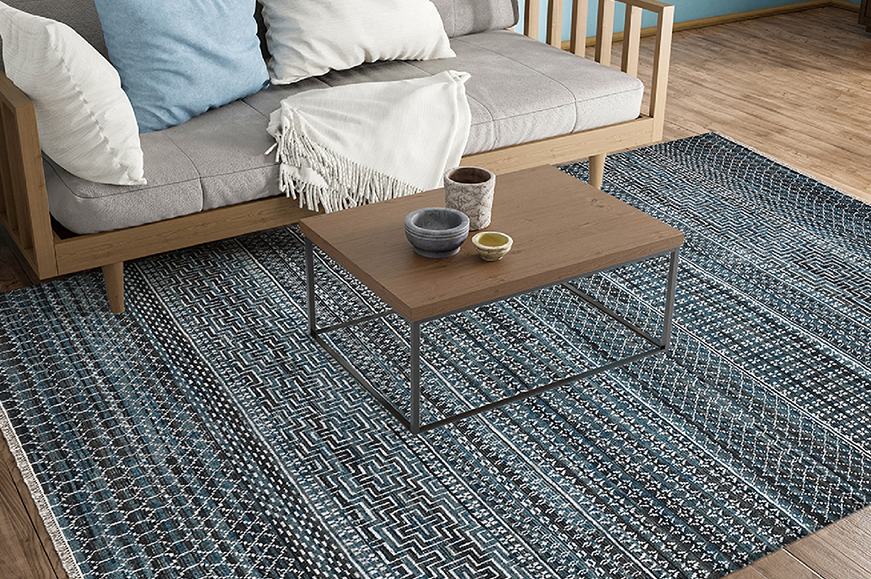Dining spaces can feel plain without the right details. Chairs and tables handle function, but atmosphere comes from softer touches. Rugs play that role beautifully. They don’t just sit under the table. They shape how the room looks, feels, and even sounds. When it comes to dining room rugs, the effect is immediate. They define the area, soften harsh flooring, and add comfort underfoot. Interior designers often consider them essentials, not extras. And while rugs shine in the dining space, the same impact carries across the home. Even something like a bedroom rug creates a similar sense of comfort and balance.
1. Framing the Dining Area
A rug under the dining table doesn’t just look good, it creates boundaries. It separates the dining zone from other spaces. In open-plan homes, this detail matters. Without it, the table and chairs sometimes look like they’re floating. A rug ties it all together. Architectural Digest even lists area rugs as one of the top tricks for making open layouts feel intentional and organized.
2. Improving Comfort Underfoot
Hard flooring feels practical but often uncomfortable during long meals. Rugs fix that problem quickly. They provide softness and warmth where it’s needed most. Psychologists studying home design say tactile comfort shapes how we feel in a space. A rug cushions steps and makes gatherings more relaxed. Guests stay longer. Meals feel warmer. That’s why dining room rugs play such an important role in making the whole experience more inviting.
3. Reducing Noise and Echo
Dining spaces can get noisy, especially with wood floors and high ceilings. Rugs help absorb sound and cut down on echoes. The American Society of Interior Designers notes that textiles are key for acoustics. Curtains help, but rugs cover the largest reflective surface the floor. With the right thickness, they make conversations clearer and dinners more enjoyable.
4. Adding Style and Personality
A rug is more than a floor covering. It’s a statement piece. It sets the tone before the first dish even arrives. Traditional Persian designs bring elegance. Bold modern prints add drama. Natural weaves keep things casual. The Metropolitan Museum of Art even highlights rugs as historical storytelling tools. In a dining space, they continue that role expressing taste, culture, and personality.
5. Balancing Proportions
Rooms often feel unfinished without something grounding the furniture. Rugs balance proportions and keep the layout visually pleasing. Designers suggest that rugs in dining spaces should extend at least 24 inches beyond the table. This way, chairs don’t slip off the edge when pulled out. Oversized rugs create a sense of harmony and luxury that smaller details can’t replicate.
6. Supporting Eco-Friendly Living
Materials matter. Wool, jute, and cotton rugs don’t just look good; they’re healthier and better for the environment. The U.S. Green Building Council points out that natural fibers improve indoor air quality. Wool, for example, resists dirt and allergens naturally. Choosing sustainable rugs turns décor into a responsible decision. It’s style with substance.
6. Seasonal Flexibility
Rugs don’t need to be permanent. They can change with the seasons, offering fresh looks throughout the year. Flat-weave rugs keep dining rooms cool and light in summer. Thicker rugs add warmth and comfort in winter. Swapping in a cozy bedroom rug during colder months can also make mornings softer and more inviting. Interior stylists often recommend rotating rugs not only for style but also to extend their lifespan. Small changes, big payoff.
8. Boosting Home Value During Staging
Real estate experts agree that staged homes sell faster. Rugs play a big role in that process. The National Association of Realtors found that staged homes attract more interest and often command higher prices. Rugs make spaces look polished and welcoming. They help buyers picture themselves at the table, enjoying the space.
Frequently Asked Questions
Do dining room rugs make cleaning harder?
Not necessarily. Flat-weave or low-pile rugs are easy to vacuum and handle spills well. Choose stain-resistant materials for busy homes.
Should dining room rugs match living room rugs?
Not always. They should complement each other, but variation adds interest. A patterned rug in the dining area paired with a simple living room rug keeps things balanced.
What size rug works best under a dining table?
Ideally, the rug should extend about two feet beyond the edges of the table. This allows chairs to move smoothly.
Can a bedroom rug serve as inspiration for dining spaces?
Yes. Many design ideas carry over. If a soft, neutral rug feels calming in the bedroom, a similar style can bring coziness to dining areas too.
Final Thoughts
Rugs may seem like minor details, but in dining spaces they carry major influence. Thoughtfully chosen dining room rugs frame the table, add comfort, and even improve acoustics. They’re not just décor, they’re part of the dining experience itself. And the impact doesn’t stop there. Whether in living areas or with a bedroom rug, the same principles apply. Rugs create warmth, define zones, and elevate style across the home. In the end, a rug isn’t just fabric under your feet. It’s a design tool that transforms everyday spaces into memorable ones.



